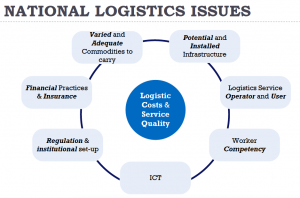Reported by Adinda Rizky Herdianti
Adiwan Aritenang (Research Center for Infrastructure and Regional Development, Bandung Institute of Technology) presented his study on “The Effect of Intergovernmental Transfers on Infrastructure Spending in Indonesia” on 18 April 2017 at LIPI. Additionally, Panky Febiyansah (The Economic Research Center, LIPI) presented a study conducted by his team regarding similar topic i.e. “Logistics Infrastructure and Connectivity in Indonesia: Enhancing Trade Competitiveness”. This descriptive study is part of an undergoing research series related to infrastructure and connectivity in Indonesia.
Panky and his team embarked from the widely recognized phenomenon in Indonesia: development has been heavily concentrated in Java and Sumatra for decades. Many even refer Java as ‘mainland’, while as Panky said, there were no island that should be treated as mainland in an archipelago nation like Indonesia. Lack of infrastructure in most islands causes high cost and low quality logistic service, which in turn worsen the price disparity and regional development imbalance in Indonesia. Panky compares Indonesia’s infrastructure capacity and the amount of international shipping with other Southeast Asian countries and shows that Indonesia is still below Singapore, Malaysia, and Thailand. Lower performance indicates that economic growth has not yet induced better infrastructure so far though Indonesia is in fact the biggest economy among those three countries. However, the fact that Indonesia’s domestic trade ratio is significantly higher than international trade ratio partly explains why Indonesia ranked below Singapore, Malaysia, and Thailand. Summing up, Panky stated that Indonesia has to still manage logistic costs and service quality issues. The issues are influenced by several factors: worker competency, ICT, financial practices, and many more.
Darwin from The Economic Research Center – LIPI suggested to Panky and his team to study further about whether or not the infrastructure development is sufficiently inclusive and to make better comparison since Singapore, Malaysia, and Thailand are not as big and complex as Indonesia in terms of geographical appearance. He mentioned China and the United States as examples of apple-to-apple comparison. Yani Mulyaningsih also suggested the team to investigate more the financing aspect of infrastructure development, particularly those of port development and shipping service.
While Panky and his team discuss infrastructure and maritime axis, Adiwan’s study is more focused on infrastructure financing. Similar to Panky, Adiwan considers high infrastructure concentration in Java and Sumatra as a threat. The enforcement of fiscal decentralization will only sustain the gap as long as resources and infrastructure disparity still exist. Hence, this study questions the extend that fiscal decentralization determines local governments’ infrastructure spending in i) regional development, housing, and settlement sector, ii) water resources, irrigation, and transportation sector, iii) telecommunication subsector, iv) mining and energy sector.
One of the empirical findings shows that capital spending on infrastructure declines in a more urbanized and larger size urban economy. Darwin suggested that this result needs further investigation since better human capital pooled in the urban are is possible to utilize the fund efficiently. On the other hand, Special Allocation Fund (Dana Alokasi Khusus, DAK) has higher effect on infrastructure spending in Java districts. Generally, this study concludes that there is a persistence economic dependence of local governments on central government support. Adiwan also suggested the central government to establish specific-purpose intergovernmental transfer budget to reduce horizontal gap.





